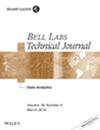下载PDF
{"title":"3D波束成形:蜂窝网络的性能改进","authors":"Hardy Halbauer, Stephan Saur, Johannes Koppenborg, Cornelis Hoek","doi":"10.1002/bltj.21604","DOIUrl":null,"url":null,"abstract":"<p>The beam pattern of a mobile communication base station has significant impact on the performance of a cellular network. Three-dimensional (3D) beamforming combines the horizontal beam pattern adaptation, as applied for beamforming and multiple input multiple output (MIMO) schemes, with a vertical antenna pattern adaptation. The recent availability of new flexible antenna techniques enables a fully dynamic antenna pattern adaptation which can be specified per resource block and user equipment (UE), and makes 3D beamforming practically feasible. This paper describes the basic principles of 3D beamforming, including the impact of downtilt adaptation on the physical layer as well as the potential of its combination with beam coordination involving the media access control (MAC) layer. Our investigations assumed the vertical main lobe of the beam pattern was geometrically pointed towards the UE. We discuss a number of different realization options and simulation results including a Bell Labs field trial with vertical beam steering. Using wireless systems with state of the art Long Term Evolution (LTE) signal format and including the lightRadio™ antenna array, our trials in the Stuttgart testbed verified the basic predicted properties and potential advantages of 3D beamforming. © 2013 Alcatel-Lucent.</p>","PeriodicalId":55592,"journal":{"name":"Bell Labs Technical Journal","volume":"18 2","pages":"37-56"},"PeriodicalIF":0.0000,"publicationDate":"2013-08-28","publicationTypes":"Journal Article","fieldsOfStudy":null,"isOpenAccess":false,"openAccessPdf":"https://sci-hub-pdf.com/10.1002/bltj.21604","citationCount":"78","resultStr":"{\"title\":\"3D Beamforming: Performance Improvement for Cellular Networks\",\"authors\":\"Hardy Halbauer, Stephan Saur, Johannes Koppenborg, Cornelis Hoek\",\"doi\":\"10.1002/bltj.21604\",\"DOIUrl\":null,\"url\":null,\"abstract\":\"<p>The beam pattern of a mobile communication base station has significant impact on the performance of a cellular network. Three-dimensional (3D) beamforming combines the horizontal beam pattern adaptation, as applied for beamforming and multiple input multiple output (MIMO) schemes, with a vertical antenna pattern adaptation. The recent availability of new flexible antenna techniques enables a fully dynamic antenna pattern adaptation which can be specified per resource block and user equipment (UE), and makes 3D beamforming practically feasible. This paper describes the basic principles of 3D beamforming, including the impact of downtilt adaptation on the physical layer as well as the potential of its combination with beam coordination involving the media access control (MAC) layer. Our investigations assumed the vertical main lobe of the beam pattern was geometrically pointed towards the UE. We discuss a number of different realization options and simulation results including a Bell Labs field trial with vertical beam steering. Using wireless systems with state of the art Long Term Evolution (LTE) signal format and including the lightRadio™ antenna array, our trials in the Stuttgart testbed verified the basic predicted properties and potential advantages of 3D beamforming. © 2013 Alcatel-Lucent.</p>\",\"PeriodicalId\":55592,\"journal\":{\"name\":\"Bell Labs Technical Journal\",\"volume\":\"18 2\",\"pages\":\"37-56\"},\"PeriodicalIF\":0.0000,\"publicationDate\":\"2013-08-28\",\"publicationTypes\":\"Journal Article\",\"fieldsOfStudy\":null,\"isOpenAccess\":false,\"openAccessPdf\":\"https://sci-hub-pdf.com/10.1002/bltj.21604\",\"citationCount\":\"78\",\"resultStr\":null,\"platform\":\"Semanticscholar\",\"paperid\":null,\"PeriodicalName\":\"Bell Labs Technical Journal\",\"FirstCategoryId\":\"1085\",\"ListUrlMain\":\"https://onlinelibrary.wiley.com/doi/10.1002/bltj.21604\",\"RegionNum\":0,\"RegionCategory\":null,\"ArticlePicture\":[],\"TitleCN\":null,\"AbstractTextCN\":null,\"PMCID\":null,\"EPubDate\":\"\",\"PubModel\":\"\",\"JCR\":\"Q1\",\"JCRName\":\"Engineering\",\"Score\":null,\"Total\":0}","platform":"Semanticscholar","paperid":null,"PeriodicalName":"Bell Labs Technical Journal","FirstCategoryId":"1085","ListUrlMain":"https://onlinelibrary.wiley.com/doi/10.1002/bltj.21604","RegionNum":0,"RegionCategory":null,"ArticlePicture":[],"TitleCN":null,"AbstractTextCN":null,"PMCID":null,"EPubDate":"","PubModel":"","JCR":"Q1","JCRName":"Engineering","Score":null,"Total":0}
引用次数: 78
引用
批量引用

 求助内容:
求助内容: 应助结果提醒方式:
应助结果提醒方式:


